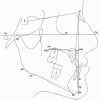Cephalometric effects of Pushing Splints 3 compared with rapid maxillary expansion and facemask therapy in Class III malocclusion children: a randomized controlled trial
- PMID: 33313718
- PMCID: PMC8186836
- DOI: 10.1093/ejo/cjaa076
Cephalometric effects of Pushing Splints 3 compared with rapid maxillary expansion and facemask therapy in Class III malocclusion children: a randomized controlled trial
Abstract
Background: Pushing Splints 3 (PS3) device was recently introduced for the treatment of Class III malocclusion in children.
Objectives: To assess the effect on the sagittal maxillary position (SNA, primary outcome) of PS3 therapy compared with rapid maxillary expansion and facemask therapy (RME/FM) and to compare skeletal and dento-alveolar effects in growing Class III patients.
Trial design: This trial was a single-centre randomized controlled trial with two groups randomly allocated in a 1:1 ratio of equal size by sealed-envelope randomization, conducted at the Dentistry Unit of Bambino Gesù Children's Hospital, IRCCS (Rome, Italy).
Methods: A total of 48 patients with Class III malocclusion were included in the study and randomly allocated to the two groups: PS3 therapy and RME/FM therapy. Only the RME/FM group underwent palatal expansion, and both groups were instructed to wear the appliances 14 hours/day. Pre- (T0) and post-treatment (T1) cephalograms were taken. An independent sample t-test and regression analysis were used to analyse the data (P value <0.05). Researchers involved in statistics and tracings were blinded to the treatment allocation.
Results: A total of 42 patients (21 for each group) completed the study. The maxillary sagittal position improved similarly in both groups (SNA = 0.4°; P = 0.547). A statistically significant decrease of SNPg angle (-1.6°; P < 0.001) and increase of ANPg angle (1.4°; P = 0.018) were found in the RME/FM group compared with PS3 group. CoGoMe angle significantly decreased in RME/FM group compared with PS3 group (-1.7°; P = 0.042). The regression analysis showed an association between SN/MP angle at T0 and the differences between T1 and T0 of SNPg (B = 0.13; P = 0.005) and SN/MP (B = -0.19; P = 0.034). Only three patients (PS3 = 2; RME/FM = 1) had breakages of the devices.
Limitations: Results are limited to short-term effects.
Conclusion: RME/FM therapy and PS3 are both effective therapies for the early correction of Class III malocclusion. The PS3 controlled better mandibular divergency reducing the clockwise rotation in patients with higher mandibular inclination.
Registration: This study was not registered in a clinical trial registry.
© The Author(s) 2020. Published by Oxford University Press on behalf of the European Orthodontic Society.
Figures




References
-
- Ngan, P. and Moon, W. (2015) Evolution of Class III treatment in orthodontics. American Journal of Orthodontics and Dentofacial Orthopedics, 148, 22–36. - PubMed
-
- Paduano, S., Rongo, R., Bucci, R., Aiello, D., Carvelli, G., Ingenito, A., Cantile, T. and Ferrazzano, G.F. (2018) Is there an association between various aspects of oral health in Southern Italy children? An epidemiological study assessing dental decays, periodontal status, malocclusions and temporomandibular joint function. European Journal of Paediatric Dentistry, 19, 176–180. - PubMed
-
- Genno, P.G., Nemer, G.M., Zein Eddine, S.B., Macari, A.T. and Ghafari, J.G. (2019) Three novel genes tied to mandibular prognathism in eastern Mediterranean families. American Journal of Orthodontics and Dentofacial Orthopedics, 156, 104–112.e3. - PubMed
-
- El-Gheriani, A.A., Maher, B.S., El-Gheriani, A.S., Sciote, J.J., Abu-Shahba, F.A., Al-Azemi, R. and Marazita, M.L. (2003) Segregation analysis of mandibular prognathism in Libya. Journal of Dental Research, 82, 523–527. - PubMed
Publication types
MeSH terms
LinkOut - more resources
Full Text Sources
Research Materials

